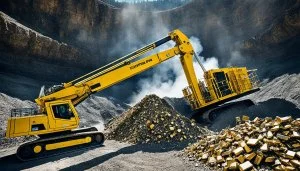The landscape of gold mining is undergoing a revolution, marked by the incorporation of innovative gold mining strategies, which are essential in today’s contemporary gold market. This article delves into valuable gold mining industry insights, underscoring technological advancements and strategic policymaking catalyzing the transformation. Adapting to this evolution cannot be overstated for those embedded in the intricate gold extraction and distribution world.
The Evolving Role Of Governments In Gold Mining
As the demand for precious metals continues to soar, governments’ influence in gold mining has become increasingly pronounced. To strengthen their economies and secure the future of their natural resources, nations are now taking a more active role in the oversight and management of gold extraction and trade. This hands-on approach by state entities includes devising public policies that aim to enhance the profitability and sustainability of gold mining, thereby making government intervention in gold mining a critical phase for stakeholders and observers alike.
Public Policy And Gold Market Influence
The intricate relationship between public policy impact and the gold market cannot be overstated, with legislative reforms playing a pivotal role in shaping the industrial framework. Modern examples such as the US Inflation Reduction Act lay down a pathway for an incredible surge in investment for clean energy sectors linked to the mining of gold and other critical minerals. Such legislative measures direct the mining industry’s trajectory and ensure that state priorities are integrated into the heart of mining operations—redefining what strategic business adjustments must be made in anticipation of future market conditions.
Funding And Investment From The State
State-funded investments in mining offer a tangible representation of government commitment to this sector. From large-scale infrastructure support to creating specialized financial facilities, governments are tackling the funding challenges that private companies often face. Agencies, such as Australia’s Export Finance Australia, display their dedication to mining through financial instruments like the Critical Minerals Facility, demonstrating an understanding that private funding alone may not match the scale of investment required for formidable and forward-looking projects. This strategic financial support enables projects that may otherwise be stifled by traditional financial constraints, ensuring the growth and evolution of the gold mining industry in alignment with public and state interests.
Decarbonization And The Path To Green Gold
At the crux of today’s gold mining innovation lies the urgent need for decarbonization. As we pave the path toward green gold production, it is evident that embracing low-carbon mining technologies is not just beneficial for the environment but also a strategic economic move. More than ever, the mining sector is aware of the critical importance of reducing carbon emissions, an initiative backed by over one-third of mining CEOs who recognize their vulnerability to climate-related risks.
Low-Carbon Technologies In Mining Operations
Integrating innovative, low-emission technologies redefines mining operations, making them cleaner and more energy-efficient. With a transition to electrified equipment and renewable energy sources, the industry is cutting down on diesel consumption and greenhouse gas emissions, thereby contributing to global decarbonization efforts in gold mining. The move towards automation and advanced processing also means a leap towards optimizing the entire value chain.
The Rise Of “Green Metals” And Sustainability Incentives
Green Metals” is becoming a powerful catchphrase, referring to minerals extracted and processed with a minimal environmental footprint. This novel branding is not just a marketing tactic but a significant shift in how gold mining companies conduct their business—setting a precedent for green gold production that aligns with global sustainability efforts. The advent of sustainability-linked financing is equally motivating, providing substantial incentives for companies that commit to ethical and environmentally sound practices. Below is a closer look at how these initiatives are forming the foundation of a sustainable mining future:
- Adoption of electric vehicles and machinery in mining operations to reduce fossil fuel reliance.
- Investment in solar, wind, and hydropower solutions to power mines, thereby decreasing carbon emissions.
- Development of carbon capture, utilization, and storage (CCUS) technologies to manage residual emissions.
- Establishment of traceability systems to assure consumers of the low environmental impact of the “green gold” they purchase.
Embracing this wave of innovation adheres to environmental standards and fortifies the industry’s financial standing by connecting to a consumer base that values sustainability. Together, these steps forge a future where decarbonization in gold mining is not an optional pathway but the gold standard for the industry.
Financial Performance Trends In Modern Gold Mining
Amidst a backdrop of economic volatilities, the gold mining sector has demonstrated resilience and strategic agility. The Top 40 mining companies have shown notable financial performance, reinforcing their robustness in an unpredictable market landscape. Gold mining revenue trends suggest an industry acutely responsive to global changes, adapting operational models to weather economic pressures and thrive within them.
Revenue Shifts And The Impact Of Economic Uncertainty
While coal staged an unexpected comeback as a top revenue contributor, its dominance is predicted to wane, giving rise to gold and other critical minerals. Economic factors in mining, such as commodity price swings and varying demands, compel the industry to pursue innovation and efficiency in operations. This drive towards sustainable profitability is particularly crucial when navigating shifts in revenue streams influenced by factors beyond market control.
Gold mines have recently experienced a surge in mergers and acquisitions, underlining a proactive approach to maintaining growth amidst economic uncertainty. This flurry of activity is part and parcel of the industry’s response to external pressures and highlights an essential strategy for securing future success.
EBITDA Margins And Operational Efficiency
Gold mining companies increasingly lean on operational efficiency to maintain strong EBITDA margin performance. Streamlined processes, cost-reduction initiatives, and technological advancement are only measures to bolster margins. Empirical evidence points to a yardstick of efficiency that, when achieved, can optimize current operations and set a foundation for enduring financial health.
- Cost management in response to fluctuating prices
- Strategic investments in technology and automation to boost productivity
- Operational adjustments to mitigate the challenges of economic factors in mining
As miners adapt to the shifting landscape, they are crafting a new narrative for the gold mining sector—one where resilience, foresight, and innovation pave the way for sustained profitability in the face of continual economic change.
Merger And Acquisition Strategies For Gold Mining Expansion
The increasing appetite for growth and efficiency in the gold mining sector has led to a significant surge in gold mining M&A strategies. With the critical task of aligning with a future defined by clean energy imperatives, mining companies have sought to bolster their operations through key acquisitions and mergers. These strategic moves are finalized not just to expand but also to adapt and thrive amid a changing economic and environmental landscape.
In the quest for expansion in gold mining, large-scale miners have turned to joint ventures as a beneficial avenue to share technology, expertise, and resources. While smaller entities may not command the same capital, strategic partnerships enable them to partake in transformative deals, consequently positioning them for impactful market entry and competitive endurance.
- Consolidation for Greater Market Share: Mergers provide a fast track to acquiring assets and increasing market share, enabling mining giants to cement their industry dominance further.
- Adapting to Market Volatility: Amid fluctuating gold prices, proactive M&A strategies hedge against market instability through diversified operations and geographies.
- Strategic Asset Acquisition: Targeting assets that complement existing operations allows miners to optimize production processes and reduce costs.
Furthermore, attention is paid to portfolio diversification in mining, which mitigates risk and ensures that investments are spread across various mineral types and mining stages. Diversification strategies are crucial for adapting to the dynamism of global demand for minerals, especially those deemed critical for technological advancements and energy applications.
- Enhance resilience against geopolitical risks and regulatory changes.
- Capitalize on opportunities across different commodities and mining life-cycle stages.
- Future-proof portfolios against industry downturns with investments in minerals essential for sustainable technologies.
As the race to secure a foothold in the minerals market intensifies, companies wielding robust M&A strategies lay the groundwork for future success. This enduring expansion ethos seeks immediate profit maximization and focuses on sustainability and long-term industry evolution.
Gold Mining Business: Leveraging Technological Innovation
As the gold mining industry ventures into the future, securing a robust position in the global market necessitates a strong affiliation with technological innovations in gold mining. Advanced technology is reshaping operations, ushering in an era in which AI and automation in mining operations are the linchpins of progress and profitability.
Automation And Digitization In Gold Extraction
The integration of automation and digitization in the context of gold extraction cannot be overstated. These advancements augment the precision of operational tasks and drastically diminish the need for manual labour, resulting in enhanced safety and efficacy on-site. Excavating gold deposits with this intersection of cutting-edge technology transforms the industry, making it poised to handle the acceleration of demand.
The Crucial Role Of AI In Modern Gold Mining Operations
AI stands at the core of modern gold mining operations, offering unprecedented capabilities for predictive maintenance, real-time analysis, and strategic decision-making. Such technologies enable miners to foresee equipment failures before they occur, optimize mine routing, and dynamically respond to changes in geologic conditions. This kind of data-driven ingenuity propels the industry toward maximized production and minimizes environmental impact, setting a new standard for intelligent resource management.
- Streamlining operations through predictive maintenance models.
- We are enhancing resource management with geospatial data analytics.
- I am boosting safety measures through automated machinery controls.
By rooting its growth in technological innovation, the gold mining industry is assuredly stepping into an era of unprecedented efficiency and sustainability, promising a golden future for all stakeholders involved.
Attracting The Workforce Of Tomorrow In Gold Mining
The vitality of the gold mining industry rests on cultivating a robust, skilled, and diverse workforce capable of driving innovation and productivity forward. As the sector evolves with technological advancements, mining workforce development becomes a pivotal area for investment to ensure competitiveness and growth. Leaders in the field are championing inclusive mining careers and deploying dynamic strategies to attract tech talent in mining, recognizing the invaluable role of fresh perspectives and digital expertise in shaping the future of mining.
Cultivating Inclusive Work Environments
The transition towards an inclusive work environment is critical to unlocking the potential of the gold mining sector. Inclusivity broadens the talent pool and fosters a culture of collaboration and innovation. Mining companies build resilience and adaptability into their operational model by breaking down barriers and nurturing a work culture that values diversity. Elements such as equal opportunities, transparent career progression, and a commitment to safety and well-being are integral to creating an environment where all employees can thrive and contribute to the industry’s success.
Strategies For Attracting Tech-Savvy Talent
- University Partnerships: Collaborate with educational institutions to introduce students to mining-related technologies, creating a pipeline of graduates eager to explore careers in the industry.
- Professional Development: Invest in continuous learning opportunities that allow employees to upskill and stay updated with technological advancements.
- Competitive Incentives: Offer compelling benefits and a competitive salary structure to attract and retain top tech talent.
- Innovation Platforms: Encourage the contribution of ideas and solutions through innovation labs or hackathons, appealing to individuals with a tech background.
- Remote Work Options: Embrace flexible work arrangements that can widen the talent pool, including remote and hybrid work possibilities, which tech professionals often favour.
Mining companies are thus poised to drive the sector into a new era, leveraging diverse expertise to solve complex challenges and embracing digital transformation to power safer, more efficient, and sustainable operations.
Gold Mine Life Cycle: From Exploration To Post-Closure
Understanding the lifecycle of a gold mine is essential to grasping the complexities and extensive efforts behind the precious metal that adorns our lives. Spanning several decades, the life cycle of a gold mine profoundly affects both the environment and local communities. This journey from discovery to recovery is a poignant narrative of human endeavour and technological advancement.
The Stages Of Gold Mine Development
The process begins with exploration, a sophisticated search through geologic time requiring extensive resources. This phase can span 1 to 10 years, and true success stories are rare; of the multitudes of prospective sites, less than 0.1% become mines. For the fortunate few, the development stage follows. At this juncture, the tangible groundwork involves arduous planning and vegetation, typically over 1 to 5 years. Here, the foundations are set for the mine and how its legacy will shape the earth and the socio-economic fabric surrounding it.
The core of the life cycle, the operation phase, sees the extraction of ore transformed into coveted doré bars. This phase’s span ranges dramatically from 10 to 30 years, with profitability hinged on fluctuating gold markets and various costs. Modern innovations have ushered in mining processes that are both smarter and more environmentally conscious.
As mines exhaust their reserves, they enter the closure phase, an era of decommissioning and contemplating the community impact of gold mining. This is coupled with an intense land rehabilitation, often lasting between 1 to 5 years. Yet, the end of active mining does not mark the end of the mine’s influence. For perhaps a decade or more, the post-closure period persists, with environmental monitoring ensuring the sublime transformation back to nature’s embrace—an epitome of environmental reclamation in mining.
Impacts On Local Communities And Long-Term Environmental Stability
The community impact of gold mining is undeniable. It brings economic activity, employment opportunities, and social change. However, displacement, environmental degradation, and socio-economic shifts can also challenge local communities. Acknowledging these impacts is vital for the mining industry to foster positive and sustainable community relations.
Responsible mining companies commit to environmental reclamation, ensuring the borrowed areas are returned to their natural state or repurposed for the community’s benefit. These practices mitigate ecological damage and enshrine the mines’ legacy as one of responsibility and respect for the gold mine lifecycle.
In summary, the progression from exploration to post-closure is an epic tale of human industry, and its chapters carefully consider the earth and its inhabitants. By valuing every stage of the gold mine lifecycle and prioritizing environmental and community stewardship, the gold mining industry continues to shine, resonating with the lustre of the precious metal itself.
The Financial Upswing In The Gold Mining Sector
Amidst a dynamic global economy, the gold mining financial boom is a beacon of profitability and resilience. The sector recently experienced notable EBITDA margin growth, with margins soaring to an estimated 40-50% in 2021. Such remarkable profitability indicators have not gone unnoticed by capital markets mining investment connoisseurs, who have seen the top 50 mining companies significantly outpace traditional market indexes. A 40% increase in market capitalization since early 2020 testifies to the sector’s robust financial health and investors’ confidence.
A crucial driver for this financial upswing has been the sustained demand, spurred partly by the socioeconomic ascent of over a billion Asian individuals predicted to reach middle-class status by 2030. This demographic shift is expected to catalyze further investments as capital markets remain eager to back a sector pivotal to the continuing urbanization and industrial development across the continent.
- Increased global demand contributes to higher gold prices.
- Pandemic-driven disruptions underscore the value of tangible assets like gold.
- Strategic capital allocation by miners to optimize financial outcomes.
The intertwining of market forces and astute investments underscores the anticipation that the gold mining financial boom is not a fleeting phenomenon but a trend poised for continuity. As gold’s allure endures, so does the eagerness of capital markets to seed the next wave of mining ventures, ensuring the industry’s relevance and growth in a rapidly transforming global economy.
Challenges And Opportunities In The Modern Gold Mining Landscape
As the global economy strides towards a net-zero future, the mining industry challenges and swells with unforeseen opportunities. The mining sector, particularly gold mining, is at the fulcrum of a pivotal transition. Navigating this landscape requires an in-depth understanding of market demands, innovative strategies to address vital material shortages, and a keen sensitivity towards the geopolitical climate that significantly impacts this dynamic industry.
Global Demand, Supply Chain Dynamics, And Production Profitability
The global demand for gold and other essential minerals shows no signs of slowing down. With economies burgeoning and new technologies emerging, the appetite for these resources continues to grow. However, this uptick in demand brings to light the critical shortages projected in crucial minerals such as copper and nickel, instigating a need for substantial investment in the mining infrastructure. To stay profitable and address these complex supply chain dynamics, industry leaders must carve out innovative paths to streamline operations, elevate production efficiency, and align themselves with sustainable practices that meet global expectations.
Geopolitical Factors And Resource Nationalism
Mining operations are susceptible to the enthusiasm of geopolitical risks, where political tensions and resource nationalism can dramatically reshape the terrain of global supply chains. Firms must remain astutely aware of the international pulse, as these factors can potentially disrupt operations and incite economic and logistical challenges. Despite such volatility, the robustness of the industry’s financial underpinnings allows mining companies the resilience and capital to invest in future projects, harnessing the influx of technological advances and pivoting towards scalable, clean mining operations.
Conclusion
The spectrum of the future of gold mining is undeniably vibrant and dynamic, reflecting a synergy of innovation and resilience in the face of numerous challenges. As geopolitical tensions persist and the crucible of labour shortages tightens, the industry is simultaneously scripting a new chapter in efficiency and sustainability. The relentless march towards sustainable mining practices is not just a romantic vision but a business imperative that aligns with global environmental and social governance trends. The reinventing of the gold mining industry is a testament to its unwavering commitment to progress, even as it navigates the complexities of market forces and policy frameworks.
Within this context, we see an industry poised on the cusp of revolutionary change, where strategic mergers and acquisitions become the chess moves that define tomorrow’s giants. Technological prowess is the wind in the sails of these enterprises, driving efficiency, bolstering safety, and ensuring a more attractive footprint upon the earth that yields its treasures. Recruiting a forward-thinking workforce is paramount, one that is equipped to operate today’s sophisticated machinery and ideate the groundbreaking technologies of the future.
Amidst economic uncertainty, the gold mining sector’s resilience stands firm. With robust financial health and strategic insight to mitigate risk, the players in this age-old industry are reinventing themselves, casting a vision of a sector not only surviving but thriving. This combination of grit, foresight, and adaptability will herald success in the industry’s quest to deliver value and virtue in equal measure. In this golden era, profit and the planet can indeed prosper together.
FAQ
How Are Governments Influencing The Contemporary Gold Market?
Governments are pivoting in shaping the modern gold mining landscape through strategic alliances, public policy reforms, and substantial state-funded investments. These actions aim to secure access to gold as a critical mineral while ensuring that mining practices support economic stability and sustainable development objectives.
What Impact Does Public Policy Have On Gold Mining?
Public policy can significantly affect gold mining by setting regulatory frameworks that govern mining activities, tax incentives or penalties, and environmental standards. Policies such as the US Inflation Reduction Act allocate funds to critical mineral supply chains, creating opportunities for strategic industry adjustments.
How Is The Gold Mining Sector Responding To The Need For Decarbonization?
The gold mining industry actively pursues decarbonization by implementing low-carbon mining technologies and processes to produce “green gold.” This includes adopting renewable energy sources, electrifying mining fleets, and efforts toward more energy-efficient operations, attracting sustainability-linked financing and reducing overall carbon emissions.
What Financial Trends Are Shaping Modern Gold Mining?
Key financial trends include robust balance sheets, significant revenue generated by the Top 40 mining companies, and a temporary surge in coal revenue. However, miners are facing a decline in EBITDA margins due to higher costs and economic uncertainties, indicating the need for strategic realignment for sustained profitability.
How Are Merger And Acquisition Strategies Influencing The Expansion Of Gold Mining Companies?
M&A strategies are crucial for gold mining companies looking to expand and diversify their portfolios, especially in the critical minerals market. In response to heightened price volatility and governmental interventions, companies seek strategic partnerships and transformative deals to align with the evolving demands of the energy transition.
What Role Does Technological Innovation Play In The Gold Mining Industry?
Technological innovations such as automation, digitization, and artificial intelligence are revolutionizing gold mining operations. These advancements enhance extraction efficiency, reduce operational costs, and contribute to the creation of safer and more sustainable mining practices, essential for the industry’s future competitiveness.
How Are Gold Mining Companies Working To Attract And Retain A Skilled Workforce?
Gold mining companies are reimagining workforce strategies to attract a diverse and tech-savvy talent pool, essential for advancing technological innovation within the industry. This includes cultivating inclusive work environments, offering competitive remuneration packages, and providing professional development opportunities to retain top talent.
Can You Explain The Stages Of The Gold Mine Life Cycle?
The gold mine life cycle comprises exploration, development, operation, closure, and post-closure. Exploration is exhaustive and lengthy, while subsequent development includes detailed planning and infrastructure construction. The operation phase involves ore processing, followed by closure and rehabilitation of the mining site, with long-term environmental monitoring.
What Is Contributing To The Financial Upswing In The Gold Mining Sector?
The gold mining sector’s financial upswing is propelled by increased demand and higher gold prices, mainly due to pandemic disruptions. This has led to margin growth and positive capital market recognition, with a significant increase in the market capitalization of the top mining companies.
How Do Global Demand And Supply Chain Dynamics Affect Gold Mining Profitability?
The surge in global demand for gold, combined with supply chain dynamics, creates opportunities and challenges for mining profitability. As the world transitions to a net-zero economy, there is an intensive demand for minerals, requiring strategic planning by mining companies to overcome shortages and maintain profitability amid volatile market conditions.
What Geopolitical Factors Pose Risks To The Gold Mining Industry?
Geopolitical tensions and the rise of resource nationalism can pose significant risks to the mining industry by affecting operations, investment climates, and supply chains. Mining companies must navigate these challenges carefully, maintaining compliance with international regulations and cultivating strategic relationships to mitigate such risks.




